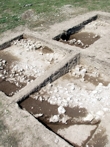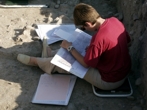|
|
| Stratigraphy / Architecture |
In every archaeological site the soil constitutes the binding material of all the finds an excavation seeks. The work of an archaeologist, however, does not comprise the removal of the earth with the aim of uncovering the desired material remains. The soil itself constitutes a source of information and every modern excavation attempts to record its characteristics meticulously, in order to gain a few extra pieces of information that will help in the difficult task of reconstructing the events that shaped the archaeological site over time. |
| |
| Stratigraphy |
 The successive accumulation of remains of human activity and of natural deposits creates distinct layers, which all together constitute the archaeological site. The stratigraphy represents the totality of archaeological layers that have been investigated, and its correct interpretation and substantiation is the most important aim of the excavation. During the removal of the soil, the excavator tries to distinguish one layer from another, so that by means of spatial connection they are able to understand the chronological sequence of their deposition. For this reason, the stratigraphic relationships between the archaeological deposits are recorded and represented diagrammatically (Harris Matrix). Analysis of the stratigraphy uncovers the sequence, the manner and the nature of the human activity that has been imprinted in the layers. The successive accumulation of remains of human activity and of natural deposits creates distinct layers, which all together constitute the archaeological site. The stratigraphy represents the totality of archaeological layers that have been investigated, and its correct interpretation and substantiation is the most important aim of the excavation. During the removal of the soil, the excavator tries to distinguish one layer from another, so that by means of spatial connection they are able to understand the chronological sequence of their deposition. For this reason, the stratigraphic relationships between the archaeological deposits are recorded and represented diagrammatically (Harris Matrix). Analysis of the stratigraphy uncovers the sequence, the manner and the nature of the human activity that has been imprinted in the layers.
|
| |
| Excavation unit |
 The basic unit of excavation is the excavation unit. It is determined by the excavator and constitutes the smallest piece into which a layer can be divided. Even though it is defined subjectively, the following of the natural stratigraphy is sought, so that each unit contains objects that belong to the same archaeological episode. Its limits are determined topographically with the help of specialised instruments, its volume is estimated in litres, and its contents are stored separately. In the excavation diary there are special fields where interpretative observations are noted about the possible use of the space in antiquity, and various characteristics of the soil are recorded, such as colour, texture, consistency, inclusions, stratification, moisture, as well as any post-depositional factors that may have affected it. Finally, samples of the soil are taken for the archive, so that there is the opportunity to re-examine it at a later stage. The basic unit of excavation is the excavation unit. It is determined by the excavator and constitutes the smallest piece into which a layer can be divided. Even though it is defined subjectively, the following of the natural stratigraphy is sought, so that each unit contains objects that belong to the same archaeological episode. Its limits are determined topographically with the help of specialised instruments, its volume is estimated in litres, and its contents are stored separately. In the excavation diary there are special fields where interpretative observations are noted about the possible use of the space in antiquity, and various characteristics of the soil are recorded, such as colour, texture, consistency, inclusions, stratification, moisture, as well as any post-depositional factors that may have affected it. Finally, samples of the soil are taken for the archive, so that there is the opportunity to re-examine it at a later stage.
|
| |
| Architectural remains |
| The removal of the layers often reveals architectural remains (immovable finds) in various states of preservation. When the find has a clear form, its characteristics are recorded on special record sheets. An emphasis is placed on its description, its planning with precise co-ordinates, the documentation of its stratigraphic relationships, its possible association with distinct floors, and the initial interpretation of its function. |
|
|
| |
| Interpretation in the field |
| Thus, during the excavation the temporal and spatial relations of each recognised human-created episode become understood and an initial image of the characteristics and interrelationships of the uncovered finds is created. These preliminary observations are very important for the course of the research, since they shape new questions for investigation and they lead the post-excavation study, which aims to either confirm or reject the initial hypotheses. |
|
|





